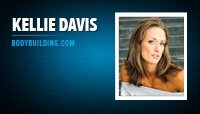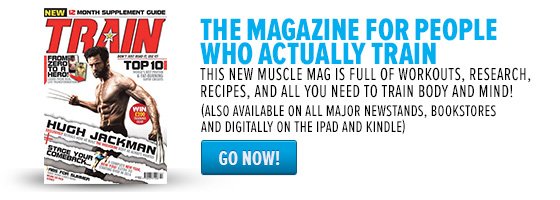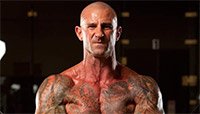Sunday 30 November 2014
30-Minute Upper-Body Workout For Women
New Exercise and Fitness Review

Vital Stats
Name: Kellie Davis
Height: 5’6″
Weight: 132 lbs
Occupation: Fitness writer and personal trainer
Website: www.motherfitness.com
Gorgeous gams and a bodacious booty aren’t the only prizes you can win with a great workout program. Michelle Obama, Cameron Diaz, and Jessica Biel are a few public figures who have impressed us with their enviable biceps and rockin’ delts.
It’s no joke, ladies. To build a better-looking, stronger, healthier body, you need to lift for your upper body!
Beauty vs. The Bulk
It is a common misconception that upper-body resistance exercise will cause women to pump up Arnold-style. Fear not, ladies! Women’s hormones and physiology such as size and shape determine our strength and muscular development. You’re not a professional bodybuilder. You don’t have to worry about looking like one.
In fact, women only have on average roughly one-tenth the testosterone that men do. Women with higher testosterone levels relative to other women may tend to develop more muscle at a faster rate, but all women can train their upper body without turning into Hulk-ettes.
To enhance your physique and create that athletic shape many women crave, you need to build your back, biceps, triceps, and delts! Size aside, the benefits to upper-body resistance training are numerous. Here are just a few reasons you should add it to your training regimen!
1 Bone modeling
Bone modeling and remodeling is the process by which bone adapts to load by changing size and shape and removing weak or damaged bone tissue. When muscles contract against bone, it creates stress that causes bones to strengthen against the contractions.1 The stronger your muscles get, the stronger your bones must become to handle muscle contractions. Bone modeling helps prevent fractures and insures against osteoporosis.
2 Connective tissue
Ligaments, tendons, and cartilage are what hold your bones together. These joints are at risk of injury when they become unstable.2 Upper-body resistance training strengthens connective tissue in the elbows, shoulders, neck, spine, wrists, and hands, improving joint integrity, stability, and injury prevention.
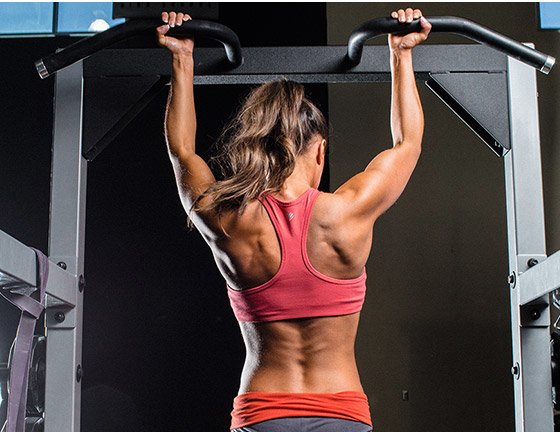
Upper-body resistance training strengthens connective tissue in the elbows, shoulders, neck, spine, wrists, and hands, improving joint integrity, stability, and injury prevention.
3 Muscle growth and fat loss
Strength exercises increase lean body mass while decreasing fat stores. The greater your proportion of lean mass to fat mass, the more metabolically active your body becomes. A metabolically active body will have increased metabolic rate, fat oxidation, and energy consumption in the form of calories.3 In other words, you burn more calories and fat simply by carrying more muscle!
4 More moxie
All things considered, having a strong, shapely upper body improves self-esteem and puts you in the ultimate badass category. In a study published in “American Journal of Health Promotion,” researchers found that women who participated in resistance training three days per week improved their body image more than women who walked three days per week (although walking is still much better than sitting on your butt all day).4 Being strong empowers both your mind and your body.
5 The ability to kick ass every day
Though we like to associate strength with killing it in the gym, a powerful upper body makes everyday tasks much simpler. You can rearrange your living room furniture without help, carry all your grocery bags in one trip, move boxes without getting a backache, and so much more! Being strong not only feels great, it grants you independence so you can take on bigger daily challenges with ease.
The Get-More-Awesome Plan
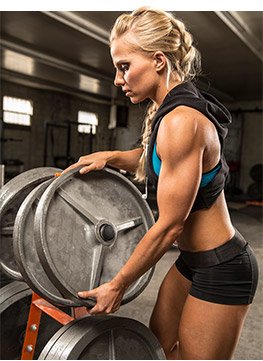
These workouts are split so that you train both the upper-body push and pull muscles equally during the week.
These workouts are broken down into push/pull sequences. These workouts are split so that you train both the upper-body push and pull muscles equally during the week.
During Workout A, you’ll concentrate on pushing, which uses the pectoral muscles as primary movers. You’ll also rely on your shoulders, trapezius muscles, and triceps for assistance.
During Workout B, you’ll do pulling exercises. These moves involve a large network of muscles that cover your back including the trapezius and rhomboids at the top of the back, the latissimus dorsi in the center of the back, and the erector spinae that run down to the bottom of the back.
Other small muscles work during these exercises, along with the biceps muscles in the arms.
I recommend performing each workout once per week, three days apart, for 4-6 weeks. You can work in lower-body days between these workouts.
Superset

 Dumbbell Bench Press
Dumbbell Bench Press
3 sets of 8-10 reps
 Dips – Triceps Version
Dips – Triceps Version
3 sets of 10-12 repsSuperset

 Dumbbell One-Arm Shoulder Press
Dumbbell One-Arm Shoulder Press
3 sets of 8-10 reps each side
 Standing Dumbbell Upright Row
Standing Dumbbell Upright Row
3 sets of 10-12 reps
 Incline Push-Up
Incline Push-Up
3 sets of 8-15 reps
 Dumbbell Skullcrusher
Dumbbell Skullcrusher
3 sets of 6-8 reps

 Chin-Up
Chin-Up
5 sets of 2-3 reps
(use assistance if necessary)Superset

 One-Arm Dumbbell Row
One-Arm Dumbbell Row
3 sets of 8-10 reps each side
 Wall-Sit Dumbbell Bicep Curl
Wall-Sit Dumbbell Bicep Curl
3 sets of 8-10 repsSuperset

 Face Pull
Face Pull
3 sets of 6-8 reps
 Rear Delt Raise
Rear Delt Raise
3 sets of 6-8 reps
 Renegade Row
Renegade Row
3 sets of 5-7 reps each side
References
- Seeman, E. (2009). Bone Modeling and Remodeling. Critical Reviews in Eukaryotic Gene Expression, 19(3), 219-233.
- Stone, M. (1988). Implications for connective tissue and bone alterations resulting from resistance exercise training. Medicine & Science in Sports & Exercise, 20(5 Suppl), S162-S168.
- Heijden, G., Wang, Z., Chu, Z., Toffolo, G., Manesso, E., Sauer, P., & Sunehag, A. (2010). Strength Exercise Improves Muscle Mass and Hepatic Insulin Sensitivity in Obese Youth. Medicine & Science in Sports & Exercise, 42(11), 1973-1980.
- Tucker, L., & Mortell, R. (1993). Comparison of the Effects of Walking and Weight Training Programs on Body Image in Middle-Aged Women: An Experimental Study. American Journal of Health Promotion, 8(1), 34-42.
Recommended For You
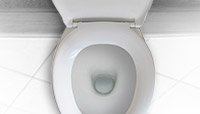
50 Shades Of Yellow: What Color Should Your Pee Be?
The color of your pee says a lot about your health. Learn what’s considered to be normal urine, and find out how much water you really need to drink!
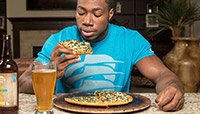
5 Dieting Mistakes You Must Avoid
Nutrition is an essential part of a fit body, but dieting can be a difficult thing to master. If you’re not seeing the results you’re after, you might be making one of these dieting mistakes! Find out what they are and how to fix them.
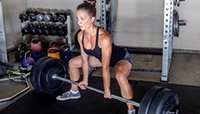
Figure Athlete To Powerlifter: My First Powerlifting Meet
Earlier this year, I signed up for my first powerlifting meet. Here’s how I trained to put on 10 pounds of muscle, an inch on my quads, and hundreds of pounds on the bar.
About The Author
Kellie Davis is a freelance writer and blogger turned fitness coach living in Northern California.
30-Minute Upper-Body Workout For Women
Protein Cracked: Mak
Protein Cracked: Making A Case For The Egg - http://ift.tt/1v0THIa
via Mark Colombus view image post
via Tumblr view image post
Protein Cracked: Making A Case For The Egg
New Exercise and Fitness Review
Egg whites are often referred to as the perfect protein, due to their amino-acid makeup and the body’s ability to utilize them properly.
The average large, whole egg contains about 72 calories, 6 g of protein, 5 g of fat, about 200 mg of cholesterol, and nearly no carbs. The average large egg white contains only 17 calories, 4 g of protein, and no carbs, fat, or cholesterol.
Egg whites contain as many as 40 different proteins. Of these, ovalbumin constitutes the majority, making up about 55 percent of the protein in egg white. Ovotransferrin is an iron-binding protein in egg whites that provides antimicrobial properties and makes up over 10 percent of the protein content. Ovomucin is another type of protein that makes up less than 5 percent of egg-white protein and provides the jellying property of egg white, as well as antimicrobial properties.
Egg-white protein is rich in BCAAs and arginine, as well as the sulfur-containing amino acids cysteine and methionine. These amino acids are critical for maintaining the structure of many proteins such as collagen, which is critical for maintaining joint health and levels of certain hormones.
Get Yolked
Although bodybuilders used to focus on just the egg white for protein, and avoided the yolk because of the fat and cholesterol— it’s now known that it’s more beneficial to consume both the egg white and the yolk together. That’s because that golden center contains the majority of the micronutrients in eggs, including vitamin A, vitamin D, vitamin K, B vitamins, selenium, iron, zinc, and phosphorus.
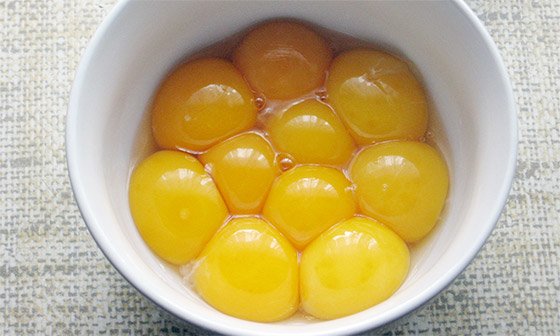
“That golden center contains the majority of the micronutrients in eggs, including vitamin A, vitamin D, vitamin K, B vitamins, selenium, iron, zinc, and phosphorus.”
The yolk also contains all of the egg’s fat and cholesterol, but don’t let that scare you off. Blood cholesterol levels don’t seem to be negatively affected by whole eggs. In fact, one study from the University of Connecticut tested the cholesterol response of 25 males and 27 females to an egg diet (640 mg per day of additional cholesterol) and a non-egg diet (no additional cholesterol). They found the cholesterol in egg yolks does not raise the LDL cholesterol particles that are particularly associated with the development of cardiovascular disease.
We now know that fat is important in a diet. The saturated fat in egg yolks is less than half of the total fat. But saturated and monounsaturated fat, also in egg yolks, are important for maintaining higher testosterone levels. The fat and cholesterol from yolks, which was once thought of as harmful, appears to provide benefits for those who do strength training.
In fact, in a head-to-head egg comparison, consuming more whole eggs was shown to help with muscle gain and strength. The magic number? Three. One study from Texas A&M found that subjects consuming three whole eggs a day while following a weight-lifting program for 12 weeks gained twice as much muscle mass and twice as much strength as subjects eating either just one egg per day or no eggs. Those kinds of benefits may be due to the cholesterol content. After all, cholesterol is converted to testosterone in the body.
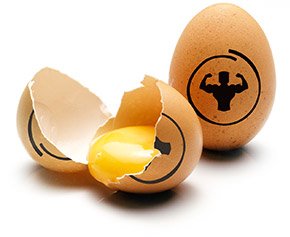
Cholesterol also helps maintain the integrity of muscle cell membranes, which helps them function properly and avoid breakdown. Scientists from Kent State University put 47 older adults (ages 60-69) on a 12-week weight-lifting program, and tested them before and after for changes in muscle mass and strength. They placed all subjects on a moderate protein diet, and divided them into two groups. One group followed a lower-cholesterol diet (1.6 mg per pound of body weight or approximately 150-250 mg per day), while the other half consumed a higher cholesterol diet (2.6 mg per pound of body weight or about 250-450 mg per day). After 12 weeks the group that consumed the lower-cholesterol diet did not increase muscle mass, and only increased their strength by about 35 percent. The higher-cholesterol group, on the other hand, had an increase in muscle mass of about 5 pounds, and upped their strength by about 90 percent.
Drop The Fat
Eggs can also help you get leaner. Research from Saint Louis University found that people who ate eggs for breakfast consumed fewer calories throughout the day than those who had a breakfast with the same amount of calories from a carb-heavy bagel. A follow-up study by the same team found that when women consumed two eggs for breakfast at least five times per week over a 12-week period, they lost 65 percent more weight and had a 34-percent larger reduction in waist size compared to those who skipped the eggs. The study also found that adding two whole eggs to breakfast resulted in no changes in cholesterol levels.
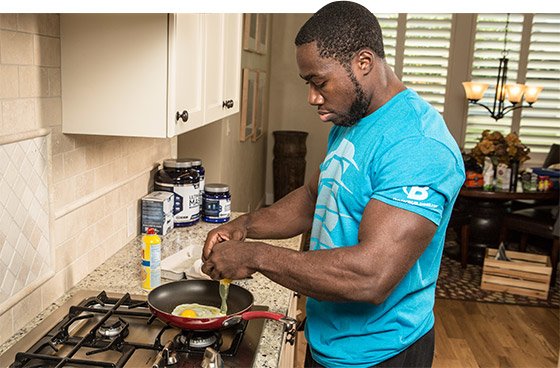
“Research from Saint Louis University found that people who ate eggs for breakfast consumed fewer calories throughout the day than those who had a breakfast with the same amount of calories from a carb-heavy bagel.”
Consider eating two or three whole eggs each day to take advantage of all the benefits eggs have to offer in regard to performance and body composition. You can bump up the protein intake by adding an extra white or two for each yolk.
While eggs are typically thought of as a breakfast food, you can enjoy them anytime throughout the day. Hardboiled eggs work great in salads or as a stand-alone snack. If you really want to kick your eggs up a notch, try my Egg and Ham Cups; they’re delicious and easy to make.
Jim’s Egg And Ham Cups
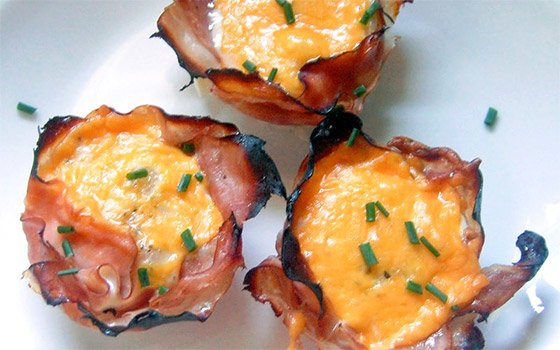
- 1 slice low-fat deli ham
- 1 large egg
- 2 tbsp shredded low-fat cheddar cheese
- 1 slice tomato (optional)
- Preheat the oven to 375°F
- Spray the cups of a muffin tin with nonstick cooking spray.
- Press the sliced ham into the muffin tin cup, forming a ham cup.
- Place the tomato slice in the cup.
- Crack the egg and drop it in on top of the tomato.
- Repeat this process for as many cups as desired.
- Place the muffin tin in the oven and bake for 10-15 minutes, or until the egg is almost cooked.
- Top with cheese and bake for an additional 3-5 minutes, or until the cheese is melted.
- Let cool for a few minutes. Once the cup has cooled, use a spatula to carefully transfer it to a plate.
- Eat with your choice of carbs, such as a piece of fruit, oats, or whole-wheat bread.
 Jim’s Egg And Ham Cups PDF (106 KB)
Jim’s Egg And Ham Cups PDF (106 KB)
Nutrition Facts
Serving Size (1 cup) Recipe yields 1
Amount per serving
Calories 144
Total Fat8 g
Total Carbs2 g
Protein15 g
References
- Yamamoto, T., et al (eds.) Hen Eggs. Their Basic and Applied Science. CRC Press, Boca Raton, FL. 1997.
- Herron, K. L. and Fernandez, M. L. Are the current dietary guidelines regarding egg consumption appropriate? J Nutrition 134:187-190. 2004.
- Herron, K. L. High intake of cholesterol results in less atherogenic low-density lipoprotein particles in men and women independent of response classification Metabolism. 53(6): 823-830, 2004.
- Layman, D.K., et al. Egg Protein as a Source of Power, Strength, and Energy. Nutrition Today 44(1) 2009, 43-48.
- Riechman, S. E., et al. Dietary and Blood Cholesterol and Statins Increase Hypertrophy with Resistance Training. Experimental Biology, San Diego, 2005.
- Dhurandhar, N. V., et al. Egg breakfast enhances weight loss. Experimental Biology Conference, Washington D.C., 2007.
- Vander Wal, J. S., et al. Short-term effect of eggs on satiety in overweight and obese subjects. J Am Coll Nutr. 2005 Dec;24(6):510-5.
- Vander Wal, J. S., et al. Short-term effect of eggs on satiety in overweight and obese subjects. J Am Coll Nutr. 2005 Dec;24(6):510-5.
Recommended For You
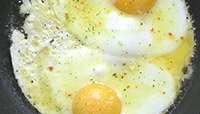
EGGS-actly What You Need To Build Muscle!
How many of you bodybuilders out there enjoy your eggs? Learn why eggs are so important to your diet and how it can help you build muscle!
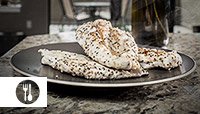
Egg-cellent: 5 Incredible Egg White Recipes
We all want to eat lean protein, but downing egg whites can be a chore. Add some variety to your meals with these egg white recipes!
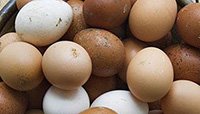
Become An Egghead: Unscramble Egg Labels And Shop Smart!
When it comes to eggs, there are more differences than whites versus yolks. Get the skinny and buy the right egg!
About The Author
Jim holds a doctorate in exercise physiology and has been the personal nutrition and health consultant for numerous celebrity clients…
Protein Cracked: Making A Case For The Egg

